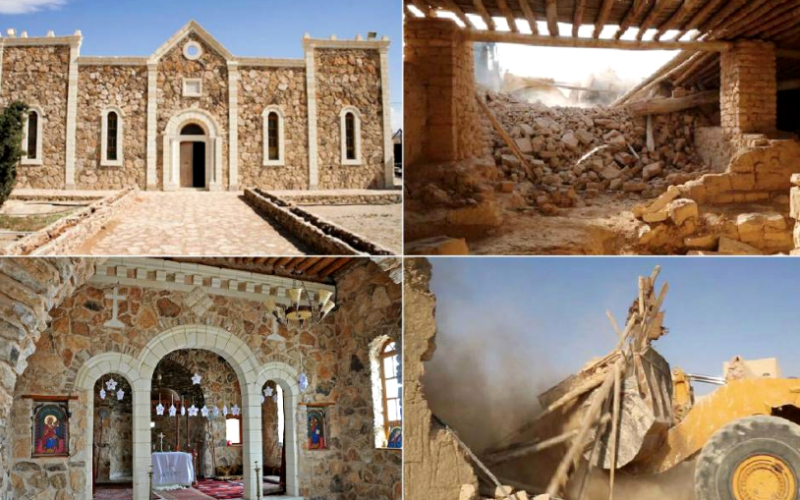
Catholic Herald magazine
When I first moved to Dayr Mar Elian in the summer of 2001 I was slightly disconcerted when the Qurwani, as the people of Qaryatayn are known, kept asking me if I had met Mar Elian yet. Since he is believed to have died more than 1,500 years ago, I thought that they meant had I seen the sarcophagus, which of course I had. When I said this I was somewhat perplexed to realise that I had misunderstood the question (complicated, of course, by my faltering Arabic and their thick regional dialect).
What the Qurwani meant was: had I spoken to the saint personally? One man told me of walking in the vicinity when a stranger accompanied and blessed him, and he later realised that the man had been Mar Elian (St Julian). The site guardian told me that late at night in the chapel a voice had repeated “God give you health” three times – which he took to be Mar Elian praying for him as he was suffering from Parkinson’s disease.
I recount this story to try to impress on the reader how central the Monastery of Mar Elian was to the local populace. The saint was a much-loved figure in the town and treated more as a venerable uncle in most homes than a distant exemplar of the faith.
What is more, in the case of that first man who had seen Mar Elian, I don’t know whether he was Christian or Muslim. The Sunni townspeople named the saint Sheikh Ahmed Khoury (Sheikh Ahmed the Priest) and the Christians of the town allowed their Muslim neighbours to place the green satin shroud of a Muslim holy man over the Byzantine sarcophagus in the monastery church. There, on a Muslim satin shroud, rosaries and saints’ cards lay with votive candles lit by those of both faiths.
Much has been written in the last few days about the physical impact of the loss of the monastery. But little consideration has been given to the psychological trauma that currently affects those of us who knew and loved the shrine. Mar Elian, or Sheikh Ahmed, was a very tangible presence in the lives of all who knew the monastery.
I know at least one family who credit the intercession of the saint for leading them to the doctor who was able to cure their young son and enable him to walk. ISIS has ripped the heart out of a poor desert community who were united in their pride in Mar Elian.
Qaryatayn is one of the remotest, poorest settlements in Syria. Located in the midst of the Syrian desert between Homs and Palmyra, it only exists because the site has a modest oasis that has permitted limited agriculture. This led to it being the centre of a kingdom in the Middle Bronze Age and, under the name Hazar-enan, Qaryatayn appears in the Old Testament (Ezekiel 47:17, 48:1; Numbers 34:9-10).
The monastery (dayr in Arabic) almost certainly dates back to around the 5th century and is considered the last resting place of Mar Elian esh-Sheikh, St Julian the Old Man, who the locals believe was the teacher of St Ephrem the Syrian, the most important of all writers in the Syriac language. The belief is that he died near Qaryatayn on his way home from a pilgrimage to Jerusalem and ordered his followers to bury him at the spot where the ox cart that carried his body halted.
The monastery appears to have been inhabited from Late Antiquity until the 18th or 19th century, when it was abandoned at the time when many of the local Christian population left the Syrian Orthodox Church to join with Rome as members of the Syrian Catholic Church.
After some legal wrangling, the monastery was finally awarded to the Syrian Catholic Church in the 1950s and was guarded by a Christian Bedouin family, who lived in the cloister until termites destroyed their mud-brick homes in the 1980s. In 2001 the Syrian Catholic Metropolitan of Homs, Mgr Georges Kassab, appointed Fr Jacques Mourad from the Community of Al-Khalil as parish priest and gave his community the task of breathing new life into the monastery. Fr Jacques was one of two founding members of the Community of Al-Khalil with his superior, Fr Paolo Dall’Oglio SJ. The two of them believed in a vocation of Abrahamic hospitality and Christian-Islamic dialogue. Both have now been kidnapped by ISIS – Fr Paolo in July 2013 and Fr Jacques in May this year.
Until Fr Jacques’ abduction Dayr Mar Elian had remained the heart of the town, comforting the local population and becoming home to hundreds of mainly Muslim internal refugees. It was a beacon of inter-faith co-operation, with Fr Jacques and the local sheikh standing side by side to prevent the town splintering along sectarian lines.
Last week ISIS broke the heart of a whole town and only time will tell if it can ever be mended. A friend from Qaryatayn who has managed to escape to Europe sent me a text on Friday that says it all: “My heart keeps crying ‘Mar Elian’.”
Emma Loosley is associate professor of Theology and Religion at the University of Exeter. To support the Community of Al-Khalil, go here
This article first appeared in the latest edition of the Catholic Herald magazine (28/8/15).